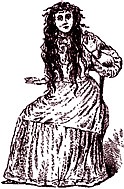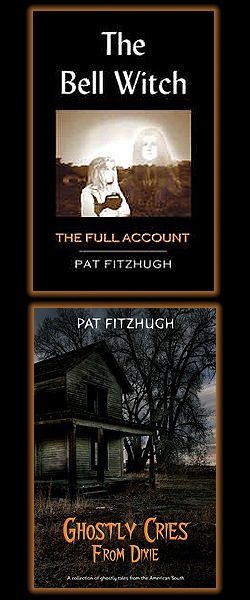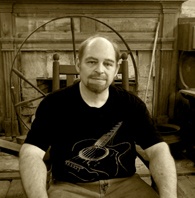The Bell Witch Site
Recommended Books
The Bell Witch SiteOn Social Media The
Bell Witch Site | Copyright © 1995
- 2025 Pat Fitzhugh On Social Media
Pat Fitzhugh's Official Web Site
|
The Early Bell Witch Accounts
"A look at two early books that helped to shape the Bell Witch legend"
Note: Two earlier, more authoritative accounts of the Bell Witch legend have been discovered in recent years. The Bell Witch Site is working to gather and post about those accounts on this page. It will take some time. Please bear with us. Thank you.
The two earliest accounts of the legend are “Authenticated History of the Bell Witch,” by M.V. Ingram, and “The Bell Witch – A Mysterious Spirit,” by Charles Bailey Bell. Known as the “Red Book” and the “Black Book,” respectively, these accounts are the basis of many modern-day accounts of the legend.
Published in 1894, “Authenticated History of the Bell Witch” was penned by Martin Ingram, a Clarksville, Tennessee newspaper editor who grew up in the Red River area. He became friends with Joel Egbert Bell, the youngest son of John Bell, later in life. This is where he reportedly first learned of the Bell Witch. Ingram did not release his book until the last of John Bell's immediate family had died, pursuant to an agreement with other family members. It was the first commercially published book about the Bell Witch legend.
At the heart of Ingram’s book is a manuscript entitled, “Our Family Trouble,” purportedly written by Richard Williams Bell, in 1846. It is believed to be the only written eyewitness account of the legend.
Ingram’s book is written in Victorian prose and is difficult to read, at best. In some cases, a whole paragraph – or even an entire page – is dedicated to describing some small detail that is of little significance, which leaves the reader thinking out loud, “just get on with the story!” A vivid backstory is important, but too much detail will distort the reader’s focus and detract from the main story.
When comparing Ingram’s descriptions to official historical data such as church, court, military and census records, one will realize that the "Authenticated History" contains a surprising number of errors. However, I do not fault Mr. Ingram because historical research is, for the most part, a hit-or-miss game – a “paper chase,” if you will – and no researcher is 100% correct 100% of the time. He also did not have the advantages of travel and technology that modern researchers have.
The collection of anecdotes in M.V. Ingram’s “Authenticated History of the Bell Witch” makes for a colorful and entertaining read, but the book's Victorian prose and numerous historical errors leave a big void in the pursuit of a serious and historically-accurate account of the Bell Witch legend. The absence of footnotes, endnotes and other scholarly matter greatly diminishes its credibility as a research tool. Key elements in the history of the legend (John Bell's excommunication from Red River Baptist Church, for example) are conspicuously absent. The book's distinction of being the first commercially published book about the legend is what makes it worthy of mention.
The Ingram book makes a great read for entertainment purposes, even with the Victorian prose, but readers should seek a more serious and thorough publication if they are interested in learning more.
The other early account, “The Bell Witch – A Mysterious Spirit,” was published in 1934 by Nashville physician, Dr. Charles Bailey Bell, a great-grandson of John Bell. Basically a rehash of the Ingram book, Dr. Bell's book is more readable and holds the reader's attention longer. Victorian prose had become obsolete by 1934, and Dr. Bell’s prose conveys the story in in much fewer words. There are two major differences between the Charles Bailey Bell book and the M.V. Ingram book.
From the beginning, Dr. Bell goes on and on about his great-grandfather’s good deeds and wonderful reputation. It is true that John Bell had a wonderful reputation – I won’t argue with that – but Dr. Bell overemphasizes it, as if trying to clear his great-grandfather’s name in connection with some past event, possibly the Red River Baptist Church ordeal, which was never even mentioned in any Bell Witch book prior to "The Bell Witch: The Full Account." While Ingram also pays tribute to Mr. Bell's reputation, he does so in a more conservative manner, only mentioning it when mention is necessary and not overdoing it. In my opinion, this is a major difference between the two early publications.
The other major difference is the inclusion of a series of “conferences” that purportedly took place between John Bell, Jr. and “Kate” in 1828, which dealt with the past, the present, and the future, as well as nature, time, and civilizations. It was during these conferences when “Kate” made several predictions that would turn out to be true – well, almost. My take on these alleged conferences can be found on the Bell Witch Questions and Answers page.
“The Bell Witch – A Mysterious Spirit,” like all other Bell Witch books, has its fair share of fans and critics alike. Old-timers say that Bell’s family was outraged by the publication. I heard one story about a woman who, after reading the book, exclaimed, “it’s a big pack of lies!” and tossed it into her fireplace. I also have heard that certain people tried to purchase every copy they could, just to keep it off of bookstore shelves. Why? The Ingram book wasn't the subject of such outrage, so why would this book? It is basically the same thing, only written better. I suspect that the “conferences,” which Ingram conspicuously avoided discussing, had something to do with it.
Bottom line, although mostly a rehash of the Ingram book, “The Bell Witch – A Mysterious Spirit” is a fascinating read. But like the Ingram book, it contains its share of historical errors.
Pat Fitzhugh, Author / Researcher
The Bell Witch Site



